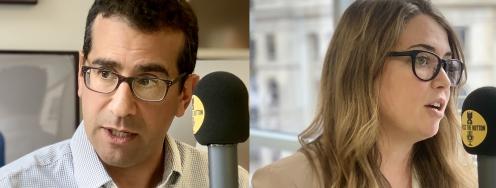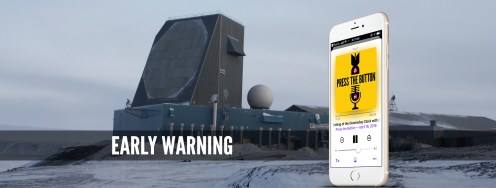Big Budgets, Risky Projects and Steep Challenges at the Nuclear Labs
On the radar: Complex choices; Sherman on Iran talks; Seriousness from Geneva; Sanctions hawks; Weaponeers dream of space; the East Coast site; and How many legs are necessary for deterrence.
October 17, 2013 | Edited by Benjamin Loehrke
Ambition and risk at the labs - “At the same time President Obama has been pressing for further reductions in U.S. and Russian nuclear arsenals, the National Nuclear Security Administration (NNSA)--a semi-autonomous agency within the Department of Energy--is planning to spend $60 billion over the next 25 years to replace existing nuclear weapons with a suite of new warheads,” writes Elliott Negin in a summary of a new report from the Union of Concerned Scientists.
--NNSA’s plans to build new nuclear production facilities and building new warheads to consolidate the number of types faces serious technical and budgetary risk and could “fly in the face” of the Obama administration’s pledge to not build new nuclear weapons. Full article at The Huffington Post. http://huff.to/1hZa2rp
Future of the complex - The above mentioned Union of Concerned Scientists report “examines the essential missions of the complex, considers its key challenges, and suggests critical near-term and long-term steps.”
--Read the full thing: “Making Smart Security Choices: The Future of the U.S. Nuclear Weapons Complex” by Lisbeth Gronlund, Eryn MacDonald, Stephen Young, Philip Coyle and Steve Fetter for the Union of Concerned Scientists. October, 2013. (pdf) http://bit.ly/16i7XkV
Must watch - Under Secretary of State Wendy Sherman, lead negotiator in Iran talks, discusses recent negotiations on CNN with Christiane Amanpour. http://bit.ly/1cxI4lX
Seriousness - “The skeptics of negotiating with Iran will continue to make unrealistic demands and point to the lack of concrete progress out of this one round of talks. But this is clearly the successful start of serious negotiations—and a negotiated deal is clearly the best option on the table to guard against a nuclear-armed Iran,” writes Daryl Kimball at Arms Control Now. Assessment of the recent Geneva talks here. http://bit.ly/17vQQwj
Welcome to Early Warning - Subscribe to our morning email or follow us on twitter.
--Have a tip or feedback for the editor? Email earlywarning@ploughshares.org earlywarning@ploughshares.org. Want to support this work? Click here.
Editor’s note - Early Warning will be on hiatus tomorrow, but will resume its regular schedule on Monday.
How negotiations went - “I have never had such intense, detailed, straight-forward, candid conversations with the Iran delegation before...The discussions took place in English…the pace of discussions was much better. It creates the ability to have a back and forth,” said an American official about the recent talks with Iran. “There are [still] serious differences,” the U.S. official said. We “got more today than we have ever gotten before, but there’s still a whole lot more we have to get.” Laura Rozen at Al Monitor has the story. http://reut.rs/19MbRFc
Statement - “Joint Statement by EU High Representative Catherine Ashton and Foreign Minister of the Islamic Republic of Iran Mohammad Javad Zarif” October 16, 2013. (pdf) http://bit.ly/1cYE9RN
Perspective - “Serious Progress and a Familiar Roadmap at Iran Nuclear Talks.” Trita Parsi asks, “Can negotiators achieve a deal on which they previously balked?” Full post at Al Jazeera America. http://alj.am/174So6o
Background - “Examining the Status of Iran’s Nuclear Program and Talks” Q&A with Rick Gladstone of The New York Times. http://nyti.ms/1ariFH0
The sanctions caucus - “The debate over increasing sanctions is quickly emerging as a standoff between Congress and the administration,” reports AP, as several hawks in Congress rush to impose new sanctions on Iran while the Obama administration pursues a diplomatic opportunity with Iran.
--The new sanctions, pushed by Senators Marco Rubio (R-FL), Mark Kirk (R-IL) and others, are expected to come before the Senate Banking Committee “shortly after the government reopens” and would mirror a similar sanctions bill in the House while calling for an oil embargo. Bradley Klapper has the story. http://abcn.ws/1bZ7agN
Iran Air Flight 655 - In 1988, the U.S. Navy accidentally shot down Iran Air Flight 655 over the Persian Gulf, killing all 290 people on the civilian airliner. The incident is largely forgotten in the U.S. but is very much remembered by Iranians. The event also deepened the severe distrust between the U.S. and Iran. Max Fisher of The Washington Post recalls the story of Flight 655 and its meaning for recent diplomacy.http://wapo.st/1etOLX0
Weaponeers look to asteroids - The Obama administration has made historic calls to reduce the roles of nuclear weapons. “But in recent years, advocates of the use of nuclear weapons to counter space threats have been gaining ground. NASA is spending hundreds of thousands of dollars a year to study the idea, and the U.S. nuclear weapons laboratories are itching to work with the Russians on it. Moreover, weaponeers in both countries are citing the asteroid threat as a reason to hold onto—or to build—very large yield nuclear explosives, which have little terrestrial justification,” writes Douglas Birch of the Center for Public Integrity.
--Birch examines the idea of using nuclear weapons for asteroid defense, the weaponeers moving the project, and the policy contradictions that follow. Full article in The Atlantic. http://bit.ly/18pnQKr
How many legs? - “Submarines Alone Are Not Enough Nuclear Deterrent” writes Col. Robert Spalding in response to a recent article on eliminating the ICBM and Bomber legs of the nuclear triad. Spalding’s response in Defense One. http://bit.ly/19TZWXV
East Coast site - A controversial congressional proposal to build an unrequested $3.6 billion missile defense site on the East Coast was welcomed by some Maine politicians but unwise, according to experts. ”Rushing ahead to build an unnecessary, expensive new site with old, ineffective technology is the wrong way to reduce the nuclear threat, or create jobs, for that matter. Maine certainly could use more investment – both public and private – but this technologically challenged program is definitely not the way to get it,” write Laura Grego and Paul Josephson in The Press Herald. http://bit.ly/GSqFsU
Tweet - @NTI_WMD: On this day in 1962, the world was at the brink of #nuclear war in the #CubanMissileCrisis.
Events:
--”Securing The Nuclear Enterprise: What Nuclear Crises Teach Us About Future Security Threats” Discussion with Matt Stokes, Henry Sokolski and Brian Finlay at Stimson. Tues. Oct. 22 from 11:30-1:00. Details here. http://bit.ly/17dNvBY
--Amb. Richard Burt and Clark Murdock debate the goal of global zero. Oct. 22nd from 6:00-8:00pm at CSIS. http://bit.ly/174Vh78
--”An Independent Assessment of the Navy’s 30 year Shipbuilding Plan” Hearing of the House Armed Services Subcommittee on Seapower and Projection with Eric Labs and Ron O’Rourke. Oct. 23rd at 2:00-4:00pm. Webcast here. http://1.usa.gov/1aREr8c


